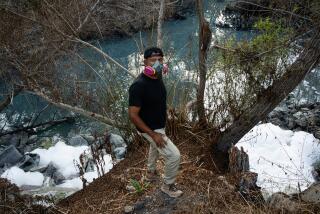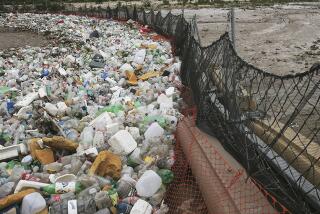Diving to Keep a City’s Sewage on the Move
- Share via
MEXICO CITY — The rainy season is fast approaching, when downpours will swamp this region’s rickety drainage system. The only thing standing between 20 million residents and streets filled with raw sewage may be Julio Cesar Cu.
Cu is a professional diver, but his domain is neither the rolling Pacific nor the glittering Caribbean.
He is part of a small team of divers who submerge themselves deep into the bowels of Mexico’s City’s sewer system to perform some of the filthiest, most frightening plumbing chores imaginable.
Like the Dutch boy who plugged the leaky sea wall with his finger, Mexico City’s sewer divers are a last line of defense against a threatening tide.
“Too many people and too much waste,” said Cu, neatly summarizing the messy task that confronts him daily in one of the world’s most densely populated urban zones.
Floating in a sea of human waste and industrial chemicals, he and three compatriots unplug pipes, repair pumps and pull the occasional cadaver from canals to keep the aguas negras, or black waters, flowing.
As if the job weren’t difficult enough, they do it completely by feel, groping in liquid so murky that flashlights are useless. The work is dangerous, poorly paid and virtually unknown to millions of Mexicans whose shoes are all the drier for the divers’ efforts.
To his knowledge, no other dive team works exclusively in the sewers.
But then no place can match Mexico City for world-class plumbing problems. Perched 7,350 feet above sea level in a valley surrounded by mountains, the area is essentially a closed basin with lousy drainage and a propensity for flooding and earthquakes.
Once dotted with shallow lakes and marshes, the valley was siphoned by the conquering Spanish to create more land for their colonial capital.
Today, drinking water must be pumped from distant rivers as well as from an underground aquifer whose rapid depletion is causing the city to sink.
Meanwhile, sewage must be pumped up and out of this bowl. It adds up to tremendous stress on a fragile drainage system already straining to keep pace with the burgeoning population.
“Mexico City is famous for its air pollution, but our water problems are actually worse,” said Homero Aridjis, a prominent environmental activist.
“You walk the streets, smell the stench of raw sewage and can only imagine what’s happening underground.”
Unlike wealthier cities, such as Los Angeles, which have separate waste and storm water networks, Mexico City has a single collection system that can fill to bursting during heavy summer rains.
Spotty enforcement of environmental regulations means that factories and hospitals routinely dump hazardous material down the sewers, where it mingles with human waste, street garbage and other urban runoff.
Most of this effluent isn’t treated before disposal. Instead, the raw sewage is channeled north out of the city via open-air canals to be used for crop irrigation in Hidalgo state.
It’s a Faustian bargain for the region’s farmers, who desperately need the water, but who have contracted cholera, parasites and other illnesses from using it on their fields.
“We’re trying to educate people about the risks,” said Ana Maria Tavarez, director of health services for Hidalgo state.
Mexico City’s divers need no such reminders. Gravely aware that each dip into the aguas negras could cause sickness, injury or worse, they encase themselves in waterproof armor to limit their exposure to the poison that surrounds them.
Having respect for “the monster” is the key to surviving it, says Cu, a sinewy 42-year-old who has spent half his life in the sewers.
After all these years, “I still have fear,” Cu said. “We never know what we’re going to encounter below.”
Inside a cluttered storage compound of the municipal waterworks department, beneath a drawing of a diver kneeling before the Virgin Mary, the divers show off the equipment to which they entrust their lives.
It starts with a bright red “dry suit,” a one-piece, synthetic-rubber garment complete with boots. Waterproof gloves come next, lashed firmly to the wrists with plenty of duct tape. A rubbery turtleneck is pulled over the throat to keep sewage from trickling under the collar. It also serves as a cushion for a steel-titanium alloy helmet that encases the head and locks snugly around the neck like a lid on a Mason jar.
The divers carry no tanks on their backs. Instead, a breathing hose connects them to an air supply on the surface. A two-way radio inside the helmet allows the submerged divers to communicate with co-workers up top. Once they resurface, they use gallons of chemical disinfectant to sanitize their bodies and equipment on the spot.
The current four-man team has had no injuries beyond a few cuts and eye infections. The work is physically demanding. Yet the divers say the biggest hurdles are psychological -- accepting that they are literally swimming in the scatological dregs of society.
“Water is water,” said Cu’s partner, Carlos Barrios, 47, tapping an index finger on his temple. “The problems are up here in your head.” He and the other divers know the inner workings of Mexico City’s 6,000-mile labyrinth of pipes and canals more intimately than the engineers who created it. Unable to see in the brackish water, they have memorized the design of pumps, motors, drains and other equipment so they can repair them by feel.
They also remove garbage. Lots of it. Plastic bottles are the most common culprit slowing the sewage flow. But the divers have encountered all manner of junk, including mattresses, furniture, water tanks, trees, even half a Volkswagen that had to be cut up and lifted out in sections.
Despite rumors of alligators and sea monsters lurking in the city’s entrails, the divers swear they have never encountered another living thing. They have, however, run across plenty of dead ones: dogs, cats, birds, goats, pigs, sheep and cows among them. That grim list extends to human beings. Cu estimates his team has recovered more than a dozen bodies for police in recent decades, mostly accident or homicide victims.
The most agonizing rescue mission came 10 years ago, when Cu and his fellow divers had to retrieve the corpse of their partner, Jose Luis Silva. The most experienced member of the dive team at the time, Silva was killed after he dislodged a tire that was blocking a floodgate west of the city. Like a stopper removed from a bathtub, the sudden suction of the free-flowing water pulled Silva through a small opening in the dam. His co-workers found his battered body more than a mile downstream.
Cu’s wife and parents begged him to leave the sewers after the tragedy. The municipal job pays $300 a month, much less than he could make as a commercial diver. Few people even know their work exists. Those who do are more likely to react with jokes or disgust than appreciation.
Still, Cu didn’t leave the job, if for no other reason that that he likes it.
“It gives me a lot of personal satisfaction,” Cu said. “This work really helps people.”
Cu and his team rode to the rescue in June 2000 in one of the region’s worst sewage disasters. Heavy summer rains caused part of an open-air canal to collapse, sending a torrent of raw sewage spewing into an impoverished neighborhood in the Valle de Chalco, east of Mexico City.
Thousands of people were forced to evacuate as a wall of waste that reached 6 feet in some places flooded homes and swamped the main highway connecting the capital to Puebla.
The divers toiled for a solid week to repair the breach. But even on a recent sunny day in Chalco, residents eyed a cloudless sky with dread.
“I worry every time it rains,” said Magdalena Baza, whose home was deluged during the 2000 flood.
Indeed, experts say an army of divers won’t be able to rescue Mexico City from its drainage problems if the region continues on its present course. Leaky sewer pipes and unlined wastewater canals are contaminating the water supply in some areas. The government has spent hundreds of millions of dollars digging new waste water tunnels to compensate for the city’s 30-foot drop over the last century. But continued depletion of the underground aquifer, a swelling population and the ever-present danger of earthquakes could someday produce a black tide that the divers will be powerless to stop.
“This is a heroic group that is guarding the life and security of a city with the most complex drainage system in the world,” said Manuel Perlo, an expert on Mexico City’s water issues at the National Autonomous University of Mexico. “But for me, it’s nothing to be proud of.... [The whole system] is an absurdity.”
More to Read
Sign up for Essential California
The most important California stories and recommendations in your inbox every morning.
You may occasionally receive promotional content from the Los Angeles Times.










